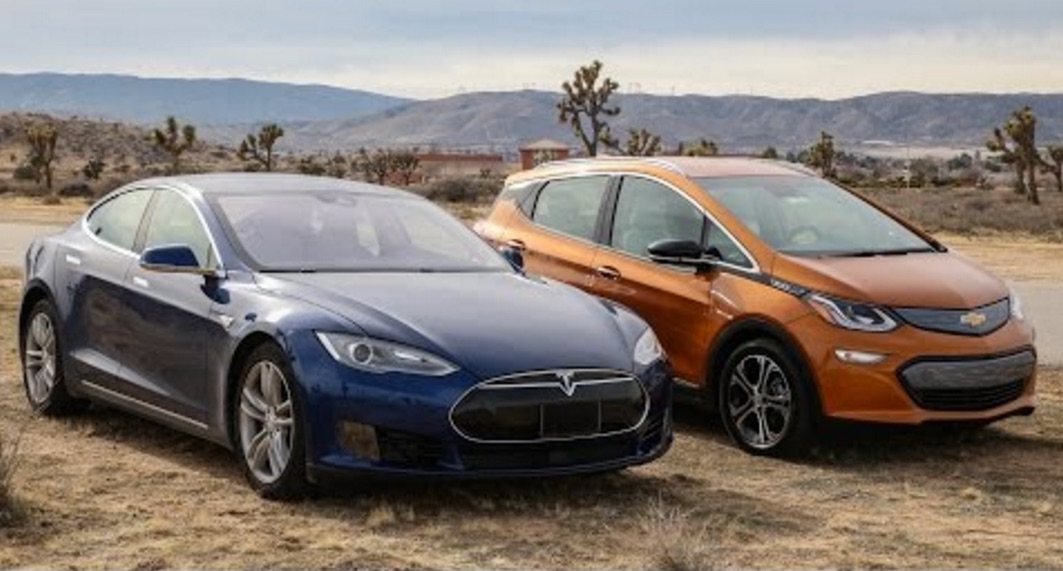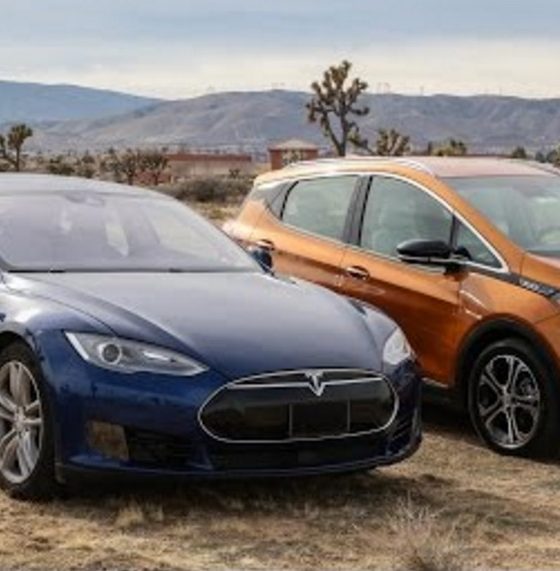

News
How the Chevy Bolt stacks up against Tesla’s production capabilities
With Tesla Model 3 production ahead of schedule, it’s not hard for the mind to wander into how it stacks up against other EVs.
Right now, the Chevy Bolt has been marked as the Model 3’s biggest competition and, with the Bolt in Musk’s crosshairs and new details emerging about Model 3 production, Musk may be hoping that increased volume will act as the trigger-pull needed to beat out the Bolt.
Production volume
As announced early Monday, the Model 3 initial exponential production could result in 10,000 Model 3s produced per week by 2018. This projection could result in 500,000 Model 3s produced in 2018 alone.
The Chevy Bolt, which is being produced at GM’s Orion Assembly Plant in Michigan, is on pace to produce around 90,000 vehicles per year, according to Reuters. This production number is significantly more cautious compared to the Model 3’s, which is aiming to be one of the highest produced electric vehicles in the nation.
In addition to to a high production goal, it’s widely reported that nearly 400,000 pre-orders have already been received for the Model 3, a number that dwarfs the Bolt’s deliveries for April at 1,929.
Production style
What makes the high-volume production of the Model 3 possible is Musk’s idea for vertically integrating both vehicle and battery production. This has resulted in both aspects of production increasing in tandem. As more Model 3s are produced, Gigafactories will continue to output lithium batteries to meet demand.
Musk thinks that that could mean over 500,000 batteries produced in 2018.
In comparison, LG Chem, the supplier of batteries for the Chevy Bolt, estimates that it will produce 30,000 batteries for the vehicle in 2017. So far it seems that the Bolt, while a sustainable and reliable option for a hatchback EV, is on a different playing field in terms of production.

Elon Musk estimates that 500,000 batteries will be produced for vehicles in 2018. Source: Tesla
Challenges
The main challenge for Tesla’s production is clearly meeting the robust goals set by founder Elon Musk. Despite initial speculation pegging 2018 as the company’s roll out for half a million Model 3s, as vehicles are made and logistics tested, the truth will emerge on whether Musk’s vision will be successful.
If you asked Musk (or even Tesla fans), it would seem as though the possibility of reaching the Model 3 production goal is inevitable.
The Bolt’s challenges are almost directly opposite to Tesla’s. While initial sales of the vehicle have been strong, GM has struggled with inventory issues in the past.
As Bolts continue to be sold, GM will have to meet the demand with increased production, something that could be difficult for a company that hasn’t prioritized high-volume logistics as much as Tesla.
Overall, it will be entertaining to watch the Model 3 and Chevy Bolt go toe-to-toe in the coming months. At the very least, it will certainly test Musk’s vertical production ideas. Based on Musk’s track record, he’s not one to shy away from the challenge.

News
Tesla FSD fleet is nearing 7 billion total miles, including 2.5 billion city miles
As can be seen on Tesla’s official FSD webpage, vehicles equipped with the system have now navigated over 6.99 billion miles.

Tesla’s Full Self-Driving (Supervised) fleet is closing in on almost 7 billion total miles driven, as per data posted by the company on its official FSD webpage.
These figures hint at the massive scale of data fueling Tesla’s rapid FSD improvements, which have been quite notable as of late.
FSD mileage milestones
As can be seen on Tesla’s official FSD webpage, vehicles equipped with the system have now navigated over 6.99 billion miles. Tesla owner and avid FSD tester Whole Mars Catalog also shared a screenshot indicating that from the nearly 7 billion miles traveled by the FSD fleet, more than 2.5 billion miles were driven inside cities.
City miles are particularly valuable for complex urban scenarios like unprotected turns, pedestrian interactions, and traffic lights. This is also the difference-maker for FSD, as only complex solutions, such as Waymo’s self-driving taxis, operate similarly on inner-city streets. And even then, incidents such as the San Francisco blackouts have proven challenging for sensor-rich vehicles like Waymos.
Tesla’s data edge
Tesla has a number of advantages in the autonomous vehicle sector, one of which is the size of its fleet and the number of vehicles training FSD on real-world roads. Tesla’s nearly 7 billion FSD miles then allow the company to roll out updates that make its vehicles behave like they are being driven by experienced drivers, even if they are operating on their own.
So notable are Tesla’s improvements to FSD that NVIDIA Director of Robotics Jim Fan, after experiencing FSD v14, noted that the system is the first AI that passes what he described as a “Physical Turing Test.”
“Despite knowing exactly how robot learning works, I still find it magical watching the steering wheel turn by itself. First it feels surreal, next it becomes routine. Then, like the smartphone, taking it away actively hurts. This is how humanity gets rewired and glued to god-like technologies,” Fan wrote in a post on X.
News
Tesla starts showing how FSD will change lives in Europe
Local officials tested the system on narrow country roads and were impressed by FSD’s smooth, human-like driving, with some calling the service a game-changer for everyday life in areas that are far from urban centers.

Tesla has launched Europe’s first public shuttle service using Full Self-Driving (Supervised) in the rural Eifelkreis Bitburg-Prüm region of Germany, demonstrating how the technology can restore independence and mobility for people who struggle with limited transport options.
Local officials tested the system on narrow country roads and were impressed by FSD’s smooth, human-like driving, with some calling the service a game-changer for everyday life in areas that are far from urban centers.
Officials see real impact on rural residents
Arzfeld Mayor Johannes Kuhl and District Administrator Andreas Kruppert personally tested the Tesla shuttle service. This allowed them to see just how well FSD navigated winding lanes and rural roads confidently. Kruppert said, “Autonomous driving sounds like science fiction to many, but we simply see here that it works totally well in rural regions too.” Kuhl, for his part, also noted that FSD “feels like a very experienced driver.”
The pilot complements the area’s “Citizen Bus” program, which provides on-demand rides for elderly residents who can no longer drive themselves. Tesla Europe shared a video of a demonstration of the service, highlighting how FSD gives people their freedom back, even in places where public transport is not as prevalent.
What the Ministry for Economic Affairs and Transport says
Rhineland-Palatinate’s Minister Daniela Schmitt supported the project, praising the collaboration that made this “first of its kind in Europe” possible. As per the ministry, the rural rollout for the service shows FSD’s potential beyond major cities, and it delivers tangible benefits like grocery runs, doctor visits, and social connections for isolated residents.
“Reliable and flexible mobility is especially vital in rural areas. With the launch of a shuttle service using self-driving vehicles (FSD supervised) by Tesla in the Eifelkreis Bitburg-Prüm, an innovative pilot project is now getting underway that complements local community bus services. It is the first project of its kind in Europe.
“The result is a real gain for rural mobility: greater accessibility, more flexibility and tangible benefits for everyday life. A strong signal for innovation, cooperation and future-oriented mobility beyond urban centers,” the ministry wrote in a LinkedIn post.
News
Tesla China quietly posts Robotaxi-related job listing
Tesla China is currently seeking a Low Voltage Electrical Engineer to work on circuit board design for the company’s autonomous vehicles.

Tesla has posted a new job listing in Shanghai explicitly tied to its Robotaxi program, fueling speculation that the company is preparing to launch its dedicated autonomous ride-hailing service in China.
As noted in the listing, Tesla China is currently seeking a Low Voltage Electrical Engineer to work on circuit board design for the company’s autonomous vehicles.
Robotaxi-specific role
The listing, which was shared on social media platform X by industry watcher @tslaming, suggested that Tesla China is looking to fill the role urgently. The job listing itself specifically mentions that the person hired for the role will be working on the Low Voltage Hardware team, which would design the circuit boards that would serve as the nervous system of the Robotaxi.
Key tasks for the role, as indicated in the job listing, include collaboration with PCB layout, firmware, mechanical, program management, and validation teams, among other responsibilities. The role is based in Shanghai.
China Robotaxi launch
China represents a massive potential market for robotaxis, with its dense urban centers and supportive policies in select cities. Tesla has limited permission to roll out FSD in the country, though despite this, its vehicles have been hailed as among the best in the market when it comes to autonomous features. So far, at least, it appears that China supports Tesla’s FSD and Robotaxi rollout.
This was hinted at in November, when Tesla brought the Cybercab to the 8th China International Import Expo (CIIE) in Shanghai, marking the first time that the autonomous two-seater was brought to the Asia-Pacific region. The vehicle, despite not having a release date in China, received a significant amount of interest among the event’s attendees.








